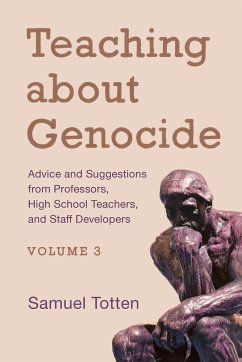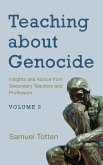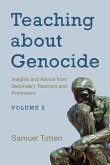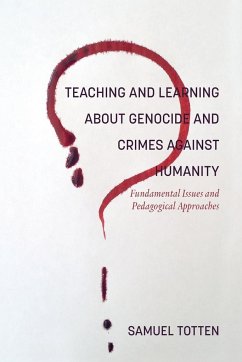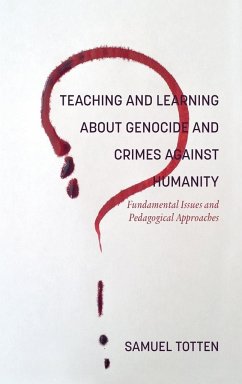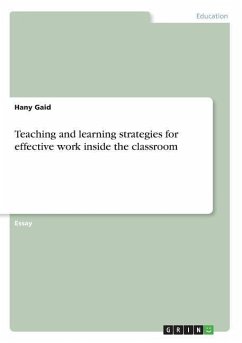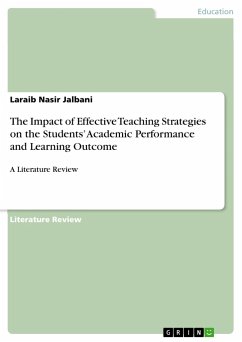Teaching about Genocide
Advice and Suggestions from Professors, High School Teachers, and Staff Developers
Herausgeber: Totten, Samuel
Teaching about Genocide
Advice and Suggestions from Professors, High School Teachers, and Staff Developers
Herausgeber: Totten, Samuel
- Broschiertes Buch
- Merkliste
- Auf die Merkliste
- Bewerten Bewerten
- Teilen
- Produkt teilen
- Produkterinnerung
- Produkterinnerung
Secondary level teachers and professors from various disciplines variously present their best advice and insights into teaching about various facets of genocide.
Andere Kunden interessierten sich auch für
![Teaching about Genocide Teaching about Genocide]() Teaching about Genocide80,99 €
Teaching about Genocide80,99 €![Teaching about Genocide Teaching about Genocide]() Teaching about Genocide42,99 €
Teaching about Genocide42,99 €![Teaching and Learning About Genocide and Crimes Against Humanity Teaching and Learning About Genocide and Crimes Against Humanity]() Samuel TottenTeaching and Learning About Genocide and Crimes Against Humanity61,99 €
Samuel TottenTeaching and Learning About Genocide and Crimes Against Humanity61,99 €![Teaching and Learning About Genocide and Crimes Against Humanity Teaching and Learning About Genocide and Crimes Against Humanity]() Samuel TottenTeaching and Learning About Genocide and Crimes Against Humanity109,99 €
Samuel TottenTeaching and Learning About Genocide and Crimes Against Humanity109,99 €![Teaching and learning strategies for effective work inside the classroom Teaching and learning strategies for effective work inside the classroom]() Hany GaidTeaching and learning strategies for effective work inside the classroom17,95 €
Hany GaidTeaching and learning strategies for effective work inside the classroom17,95 €![The Impact of Effective Teaching Strategies on the Students' Academic Performance and Learning Outcome The Impact of Effective Teaching Strategies on the Students' Academic Performance and Learning Outcome]() Laraib Nasir JalbaniThe Impact of Effective Teaching Strategies on the Students' Academic Performance and Learning Outcome5,99 €
Laraib Nasir JalbaniThe Impact of Effective Teaching Strategies on the Students' Academic Performance and Learning Outcome5,99 €![Creating Innovators Creating Innovators]() Tony WagnerCreating Innovators15,99 €
Tony WagnerCreating Innovators15,99 €-
-
-
Secondary level teachers and professors from various disciplines variously present their best advice and insights into teaching about various facets of genocide.
Produktdetails
- Produktdetails
- Verlag: Rowman & Littlefield Publishers
- Seitenzahl: 312
- Erscheinungstermin: 15. Oktober 2020
- Englisch
- Abmessung: 229mm x 152mm x 18mm
- Gewicht: 509g
- ISBN-13: 9781475856002
- ISBN-10: 1475856008
- Artikelnr.: 59542638
- Herstellerkennzeichnung
- Libri GmbH
- Europaallee 1
- 36244 Bad Hersfeld
- gpsr@libri.de
- Verlag: Rowman & Littlefield Publishers
- Seitenzahl: 312
- Erscheinungstermin: 15. Oktober 2020
- Englisch
- Abmessung: 229mm x 152mm x 18mm
- Gewicht: 509g
- ISBN-13: 9781475856002
- ISBN-10: 1475856008
- Artikelnr.: 59542638
- Herstellerkennzeichnung
- Libri GmbH
- Europaallee 1
- 36244 Bad Hersfeld
- gpsr@libri.de
Samuel Totten, a longtime scholar of genocide studies and retired professor (University of Arkansas, Fayetteville), is the author of Teaching About Crimes Against Humanity and Genocide: Fundamental Issues and Approaches (Information Age Publishing, 2018). Over the past fourteen years he has conducted field work into crimes against humanity and genocide in the refugee camps along the Chad/Darfur, Sudan border, and in the Nuba Mountains of Sudan.
Part 1: High School Teachers and Staff Developers
Chapter 1: "Providing Students with the Opportunity to Engage with
Survivors of Genocide" by Michael Anthony
Chapter 2: "A Global Collaborative Approach to Genocide Education" by Kate
Weckesser English
Chapter 3: "The Bosnian Genocide: Teaching Ideas and Resources"by Lisa M.
Adeli
Chapter 4: "Happening Now: The Rohingya Genocide in Myanmar, A Jigsaw
Activity Using Mace's 10 Stages of Genocide" by Frank J. Pérez
Part 2: Professors
Chapter 5: "If 'Never Again!' Is a Key Theme of Genocide Studies, Perhaps
the Typical Approach to Genocide Education Needs to Be Reconsidered" by
Samuel Totten
Chapter 6: "Teaching 'Introduction to Genocide Studies'" by Ashley L.
Greene.
Chapter 7: "Rewriting the Genocide Convention" byTracy H. Slagter
Chapter 8: "Our Nature in Genocide: Teaching Atrocity from Within the Human
Continuum" by Timothy Horner
Chapter 9: "Extraordinary Atrocities, Ordinary People: Teaching Genocide
through the Lenses of Banal and Fetishized Evils" by Cathryn van Kessel
Chapter 10: "Moving Beyond Perpetrators, Victims, Bystanders, and
Upstanders" by Hollie Nyseth Brehm and Michelle L. O'Brien
Chapter 11: "Teaching About Perpetrators and Perpetration in Genocide" by
Timothy Williams
Chapter 12 :"Understanding Perpetrators?" by Susanne C. Knittel
Chapter 13: "Confronting Mass Atrocities: Interplays Between Legal Norms,
Political Interests, and Moral Imperatives for Action" by Eyal Mayroz
Chapter 14 :"Teaching About Resistance to Genocide"by Khatchig Mouradian
Chapter 15 :"Balkan Stereotypes and the Problem of Teaching Southeastern
European Genocide" by James Frusetta
Chapter 16: "From Student to Citizen: The Impact of Personal Narratives in
University-Level Genocide Education" by Ari Kohen and Gerald J. Steinacher
Chapter 17: "Does Place Matter? Using Inquiry to Explore the Geography of
Genocide" by Aaron Johnson and Lisa Pennington
Chapter 18: "The Complexity of Genocide: Atrocity Prevention and
Interactive Learning" by Benjamin Meiches
Chapter 19: "Teaching Economic Aspects of Genocide and Their Prevention" by
Charles H. Anderton
Chapter 20: "In the Margins: Teaching About Genocide While Teaching
Writing" by Taleen Mardirossian
Chapter 21: "Advice on Teaching About Genocide with Film" by Glenn Mitoma
and Alan S. Marcus
Chapter 22: "Art and Genocide in University Classrooms" by Mark Celinscak
Chapter 23: "Genocide Site Visits as an Educational Tool: A Bosnian
Experience" by Hikmet Karcic.
Chapter 24: "Developing an 'Heroic Imagination' through Study Abroad in
Guatemala by Trisha Posey and Kevin Simpson
Chapter 25: "The Potential and Limitations of Student Fieldwork on
Continents and in Nations Other Than Their Own" by Timothy Williams
Chapter 26: "Genocide and the Promise of Positive Peace" by James G. Brown
Chapter 1: "Providing Students with the Opportunity to Engage with
Survivors of Genocide" by Michael Anthony
Chapter 2: "A Global Collaborative Approach to Genocide Education" by Kate
Weckesser English
Chapter 3: "The Bosnian Genocide: Teaching Ideas and Resources"by Lisa M.
Adeli
Chapter 4: "Happening Now: The Rohingya Genocide in Myanmar, A Jigsaw
Activity Using Mace's 10 Stages of Genocide" by Frank J. Pérez
Part 2: Professors
Chapter 5: "If 'Never Again!' Is a Key Theme of Genocide Studies, Perhaps
the Typical Approach to Genocide Education Needs to Be Reconsidered" by
Samuel Totten
Chapter 6: "Teaching 'Introduction to Genocide Studies'" by Ashley L.
Greene.
Chapter 7: "Rewriting the Genocide Convention" byTracy H. Slagter
Chapter 8: "Our Nature in Genocide: Teaching Atrocity from Within the Human
Continuum" by Timothy Horner
Chapter 9: "Extraordinary Atrocities, Ordinary People: Teaching Genocide
through the Lenses of Banal and Fetishized Evils" by Cathryn van Kessel
Chapter 10: "Moving Beyond Perpetrators, Victims, Bystanders, and
Upstanders" by Hollie Nyseth Brehm and Michelle L. O'Brien
Chapter 11: "Teaching About Perpetrators and Perpetration in Genocide" by
Timothy Williams
Chapter 12 :"Understanding Perpetrators?" by Susanne C. Knittel
Chapter 13: "Confronting Mass Atrocities: Interplays Between Legal Norms,
Political Interests, and Moral Imperatives for Action" by Eyal Mayroz
Chapter 14 :"Teaching About Resistance to Genocide"by Khatchig Mouradian
Chapter 15 :"Balkan Stereotypes and the Problem of Teaching Southeastern
European Genocide" by James Frusetta
Chapter 16: "From Student to Citizen: The Impact of Personal Narratives in
University-Level Genocide Education" by Ari Kohen and Gerald J. Steinacher
Chapter 17: "Does Place Matter? Using Inquiry to Explore the Geography of
Genocide" by Aaron Johnson and Lisa Pennington
Chapter 18: "The Complexity of Genocide: Atrocity Prevention and
Interactive Learning" by Benjamin Meiches
Chapter 19: "Teaching Economic Aspects of Genocide and Their Prevention" by
Charles H. Anderton
Chapter 20: "In the Margins: Teaching About Genocide While Teaching
Writing" by Taleen Mardirossian
Chapter 21: "Advice on Teaching About Genocide with Film" by Glenn Mitoma
and Alan S. Marcus
Chapter 22: "Art and Genocide in University Classrooms" by Mark Celinscak
Chapter 23: "Genocide Site Visits as an Educational Tool: A Bosnian
Experience" by Hikmet Karcic.
Chapter 24: "Developing an 'Heroic Imagination' through Study Abroad in
Guatemala by Trisha Posey and Kevin Simpson
Chapter 25: "The Potential and Limitations of Student Fieldwork on
Continents and in Nations Other Than Their Own" by Timothy Williams
Chapter 26: "Genocide and the Promise of Positive Peace" by James G. Brown
Part 1: High School Teachers and Staff Developers
Chapter 1: "Providing Students with the Opportunity to Engage with
Survivors of Genocide" by Michael Anthony
Chapter 2: "A Global Collaborative Approach to Genocide Education" by Kate
Weckesser English
Chapter 3: "The Bosnian Genocide: Teaching Ideas and Resources"by Lisa M.
Adeli
Chapter 4: "Happening Now: The Rohingya Genocide in Myanmar, A Jigsaw
Activity Using Mace's 10 Stages of Genocide" by Frank J. Pérez
Part 2: Professors
Chapter 5: "If 'Never Again!' Is a Key Theme of Genocide Studies, Perhaps
the Typical Approach to Genocide Education Needs to Be Reconsidered" by
Samuel Totten
Chapter 6: "Teaching 'Introduction to Genocide Studies'" by Ashley L.
Greene.
Chapter 7: "Rewriting the Genocide Convention" byTracy H. Slagter
Chapter 8: "Our Nature in Genocide: Teaching Atrocity from Within the Human
Continuum" by Timothy Horner
Chapter 9: "Extraordinary Atrocities, Ordinary People: Teaching Genocide
through the Lenses of Banal and Fetishized Evils" by Cathryn van Kessel
Chapter 10: "Moving Beyond Perpetrators, Victims, Bystanders, and
Upstanders" by Hollie Nyseth Brehm and Michelle L. O'Brien
Chapter 11: "Teaching About Perpetrators and Perpetration in Genocide" by
Timothy Williams
Chapter 12 :"Understanding Perpetrators?" by Susanne C. Knittel
Chapter 13: "Confronting Mass Atrocities: Interplays Between Legal Norms,
Political Interests, and Moral Imperatives for Action" by Eyal Mayroz
Chapter 14 :"Teaching About Resistance to Genocide"by Khatchig Mouradian
Chapter 15 :"Balkan Stereotypes and the Problem of Teaching Southeastern
European Genocide" by James Frusetta
Chapter 16: "From Student to Citizen: The Impact of Personal Narratives in
University-Level Genocide Education" by Ari Kohen and Gerald J. Steinacher
Chapter 17: "Does Place Matter? Using Inquiry to Explore the Geography of
Genocide" by Aaron Johnson and Lisa Pennington
Chapter 18: "The Complexity of Genocide: Atrocity Prevention and
Interactive Learning" by Benjamin Meiches
Chapter 19: "Teaching Economic Aspects of Genocide and Their Prevention" by
Charles H. Anderton
Chapter 20: "In the Margins: Teaching About Genocide While Teaching
Writing" by Taleen Mardirossian
Chapter 21: "Advice on Teaching About Genocide with Film" by Glenn Mitoma
and Alan S. Marcus
Chapter 22: "Art and Genocide in University Classrooms" by Mark Celinscak
Chapter 23: "Genocide Site Visits as an Educational Tool: A Bosnian
Experience" by Hikmet Karcic.
Chapter 24: "Developing an 'Heroic Imagination' through Study Abroad in
Guatemala by Trisha Posey and Kevin Simpson
Chapter 25: "The Potential and Limitations of Student Fieldwork on
Continents and in Nations Other Than Their Own" by Timothy Williams
Chapter 26: "Genocide and the Promise of Positive Peace" by James G. Brown
Chapter 1: "Providing Students with the Opportunity to Engage with
Survivors of Genocide" by Michael Anthony
Chapter 2: "A Global Collaborative Approach to Genocide Education" by Kate
Weckesser English
Chapter 3: "The Bosnian Genocide: Teaching Ideas and Resources"by Lisa M.
Adeli
Chapter 4: "Happening Now: The Rohingya Genocide in Myanmar, A Jigsaw
Activity Using Mace's 10 Stages of Genocide" by Frank J. Pérez
Part 2: Professors
Chapter 5: "If 'Never Again!' Is a Key Theme of Genocide Studies, Perhaps
the Typical Approach to Genocide Education Needs to Be Reconsidered" by
Samuel Totten
Chapter 6: "Teaching 'Introduction to Genocide Studies'" by Ashley L.
Greene.
Chapter 7: "Rewriting the Genocide Convention" byTracy H. Slagter
Chapter 8: "Our Nature in Genocide: Teaching Atrocity from Within the Human
Continuum" by Timothy Horner
Chapter 9: "Extraordinary Atrocities, Ordinary People: Teaching Genocide
through the Lenses of Banal and Fetishized Evils" by Cathryn van Kessel
Chapter 10: "Moving Beyond Perpetrators, Victims, Bystanders, and
Upstanders" by Hollie Nyseth Brehm and Michelle L. O'Brien
Chapter 11: "Teaching About Perpetrators and Perpetration in Genocide" by
Timothy Williams
Chapter 12 :"Understanding Perpetrators?" by Susanne C. Knittel
Chapter 13: "Confronting Mass Atrocities: Interplays Between Legal Norms,
Political Interests, and Moral Imperatives for Action" by Eyal Mayroz
Chapter 14 :"Teaching About Resistance to Genocide"by Khatchig Mouradian
Chapter 15 :"Balkan Stereotypes and the Problem of Teaching Southeastern
European Genocide" by James Frusetta
Chapter 16: "From Student to Citizen: The Impact of Personal Narratives in
University-Level Genocide Education" by Ari Kohen and Gerald J. Steinacher
Chapter 17: "Does Place Matter? Using Inquiry to Explore the Geography of
Genocide" by Aaron Johnson and Lisa Pennington
Chapter 18: "The Complexity of Genocide: Atrocity Prevention and
Interactive Learning" by Benjamin Meiches
Chapter 19: "Teaching Economic Aspects of Genocide and Their Prevention" by
Charles H. Anderton
Chapter 20: "In the Margins: Teaching About Genocide While Teaching
Writing" by Taleen Mardirossian
Chapter 21: "Advice on Teaching About Genocide with Film" by Glenn Mitoma
and Alan S. Marcus
Chapter 22: "Art and Genocide in University Classrooms" by Mark Celinscak
Chapter 23: "Genocide Site Visits as an Educational Tool: A Bosnian
Experience" by Hikmet Karcic.
Chapter 24: "Developing an 'Heroic Imagination' through Study Abroad in
Guatemala by Trisha Posey and Kevin Simpson
Chapter 25: "The Potential and Limitations of Student Fieldwork on
Continents and in Nations Other Than Their Own" by Timothy Williams
Chapter 26: "Genocide and the Promise of Positive Peace" by James G. Brown

